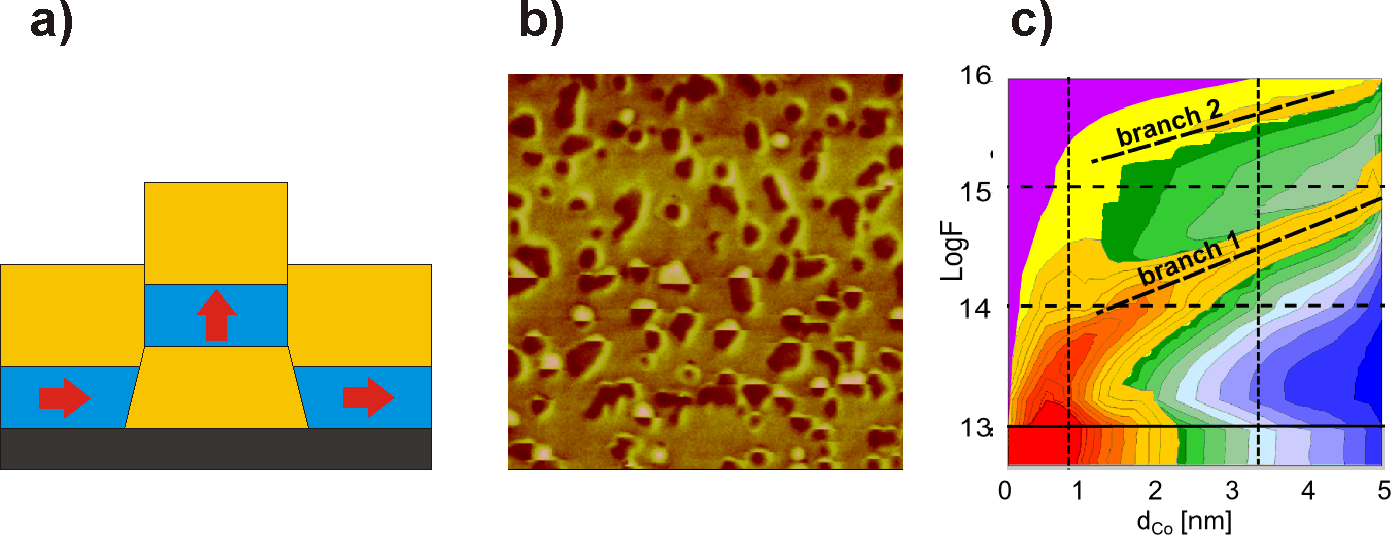| Search for content and authors |
Structural aspects of nanoscale magnetic patterning of epitaxial metallic thin films |
| Andrzej Wawro 1, Ewelina Sieczkowska 1, Marcin Jakubowski 1, Lech T. Baczewski 1, Zbigniew Kurant 2, Piotr Mazalski 2, Andrzej Maziewski 2 |
|
1. Polish Academy of Sciences, Institute of Physics, al. Lotników 32/46, Warszawa 02-668, Poland |
| Abstract |
| Magnetic layered structures spatially patterned in a nanoscale are of great scientific interest and high technological relevance. Such systems are excellent objects to perform fundamental studies on nanomagnetism as well as they are promising for practical applications: as magnonic crystals, sources of local magnetic fields in spintronics devices, or as magnetic recording media, in which undesired influence of superparamagnetic effects is substantially reduced. In this work we discuss different methods of magnetic patterning of Co-based sandwiches: by a spatially structured buffer and by irradiation with an ion beam. Magnetic properties studied by magnetometry utilizing magnetooptical Kerr effect (MOKE) and magnetic force microscopy (MFM) are correlated with structural features of the investigated patterned systems. In the first method magnetic patterning is induced by deposition of a Co layer on a structured buffer in the form of Au islands, few hundred nanometers in lateral size, self-assembled on a Mo layer surface [1]. Observed Volmer-Weber growth mode is a consequence of surface energy interplay of low-index free atomic planes of Au and Mo and Mo/Au interface as well as elastic energy originating from a lattice mismatch. Due to strong dependence of magnetic anisotropy on a buffer/Co-film interface type, a system of elevated magnetic dots (Co layer grown on the top of the Au islands) embedded in the magnetic trench matrix (Co layer deposited between the Au islands on the Mo layer surface) with various dot - matrix magnetization orientations (Fig. 1a) has been fabricated [2, 3]. A buffer material influences the surface anisotropy due to hybridization of electron orbitals at the interface and magnetoelastic contribution resulting from the lattice mismatch. Moreover, the structure of the buffer affects the growth of the Co layer and in consequence – the magnetocrystalline anisotropy. As the size of the magnetic dots is determined by dimensions of the Au islands, tuning of magnetic properties of the dots and their surface density becomes possible by control of the Au islands growth conditions on the Mo layer surface. Combination of the results obtained from the PMOKE and MFM reveals magnetization switching mechanism of the dots by nucleation of a reversed domain followed by rapid and unpinned domain wall propagation (Fig. 1b). High crystalline quality of the studied epitaxial patterned structures, which are not exposed to any post-growth treatment, explains a monodomain character of the magnetic dots. Low amount of structural defects, confined dimensions and stiffer magnetization at the edges are responsible for higher nucleation field of the reversed domain in the dot in comparison with the uniform Au/Co/Au reference film. For the same reason the domain wall propagation is unperturbed. Thus, once nucleated, the reversed domain expands rapidly by the domain wall propagation over whole area of the dot. In the second method the Pt/Co/Pt sandwiches are irradiated by an ion beam. As-deposited structure with in-plane magnetization exhibits consecutive reorientation spin transitions from in-plane to out-of-plane alignments and vice versa with an increasing fluence of the beam (Fig. 1c) [4, 5]. Observed behavior results from two competitive processes undergoing upon irradiation: (i) degradation of the interfaces (initially with a sharp chemical profile) which suppresses PMA and (ii) formation of ordered CoPt alloys exhibiting enhanced PMA. In-depth chemical profile and composition of the forming intermetallic alloys were estimated with use of TRIDYN simulations. Results obtained from these simulations and those revealed from XMCD measurements lead to a conclusion that L10 and L12 phases are responsible for PMA appearance with increasing irradiation fluence. Controlled irradiation of the Pt/Co/Pt sandwiches with focused ion beam is expected to allow fabrication of structures periodically patterned in a nanoscale with desired properties of the irradiated spots. Acknowledgement: This work has been partially supported by the National Science Center in Poland under the project no. DEC-2011/03/N/ST3/02662 and by the Foundation for Polish Science under the SYMPHONY project operated within the Team Programme, co-financed by the EU European Regional Development Fund, OPIE 2007-2013.  Fig.1. a) schematic representation of a magnetic dot with perpendicular magnetization embedded in a matrix magnetized in the plane (black: Mo buffer, blue: Co layer, yellow: Au island and cap layer, red arrows: magnetization directions); b) magnetization reversal (visible in the lower part of the MFM image) of the dots while scanning with a magnetic tip; c) a diagram (dCo - Co layer thickness; F- Ga ion fluence) of magnetization orientation in Pt/Co/Pt sandwiches. Two branches of perpendicular magnetization are distinct (blue and green – magnetization in-plane; yellow and red – perpendicular magnetization, magenta – superparamagnetic state) [4]. [1] A. Wawro, M. Sobańska, A. Petroutchik, L. T. Baczewski and P. Pankowski, Nanotechnology 21, 335606 (2010).[2] A. Wawro, A. Petroutchik, L. T. Baczewski, Z. Kurant and A. Maziewski, Europhys. Lett. 89, 37003 (2010). [3] A. Wawro, E. Sieczkowska, A. Petroutchik, L.T. Baczewski, Z. Kurant, A. Maziewski, Phys Rev. B 83, 092405 (2011). [4] A. Maziewski, P. Mazalski, Z. Kurant, M.O. Liedke, J. McCord, J. Fassbender, J. Ferré, A. Mougin, A. Wawro, L.T. Baczewski, A. Rogalev, F. Wilhelm, T. Gemming, Phys. Rev. B 85, 054427 (2012). [5] P. Mazalski, Z. Kurant, A. Maziewski, M. O. Liedke, J. Fassbender, L. T. Baczewski, A. Wawro J. Appl. Phys. 113 17C109 (2013). |
| Legal notice |
|
| Related papers |
Presentation: Invited oral at 17th International Conference on Crystal Growth and Epitaxy - ICCGE-17, General Session 8, by Andrzej WawroSee On-line Journal of 17th International Conference on Crystal Growth and Epitaxy - ICCGE-17 Submitted: 2013-04-15 12:24 Revised: 2013-07-15 17:05 |